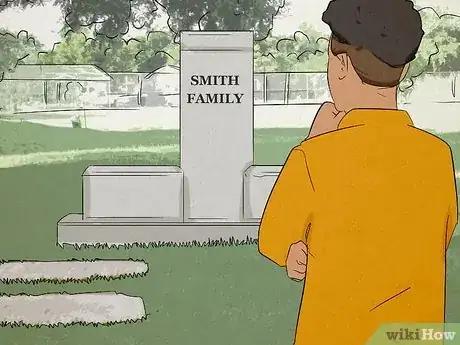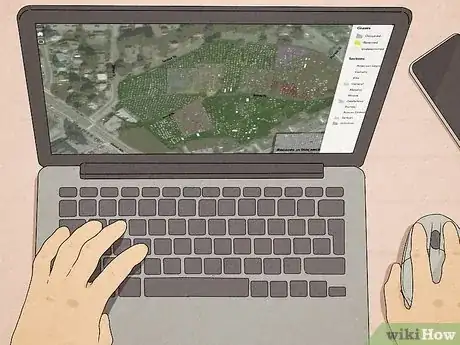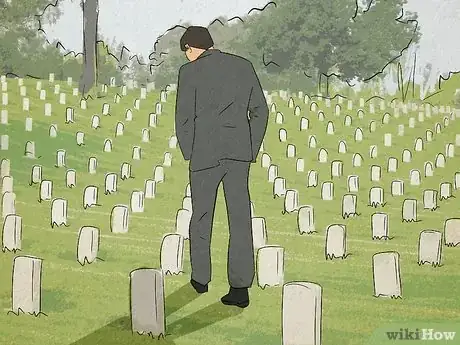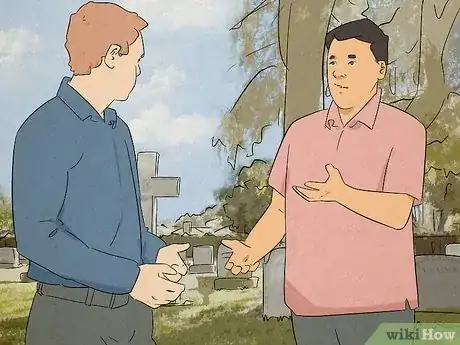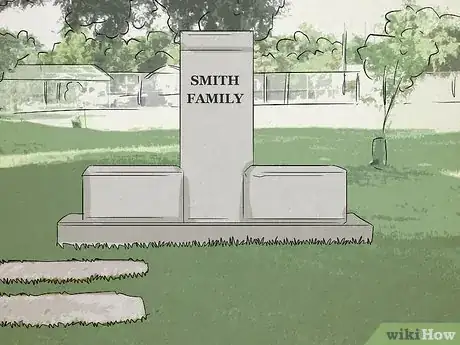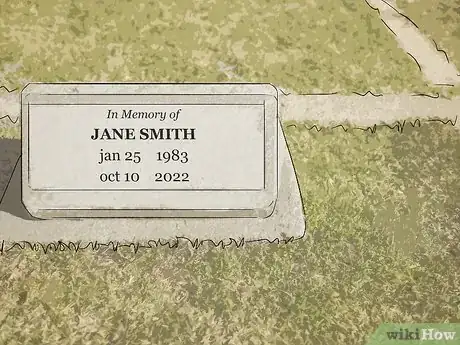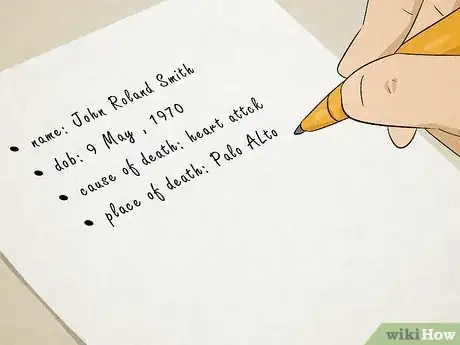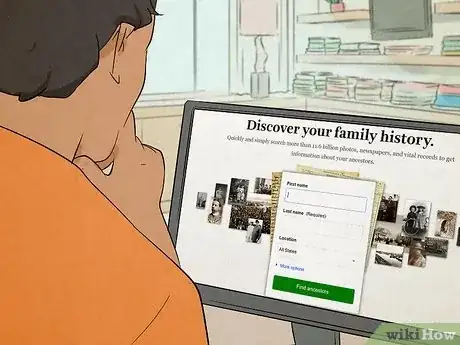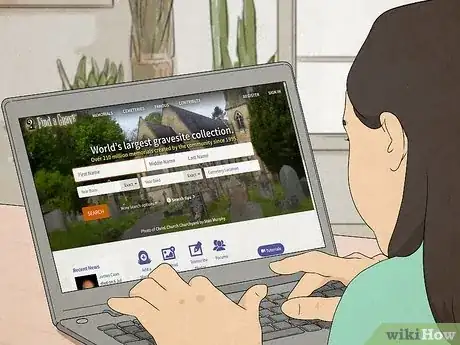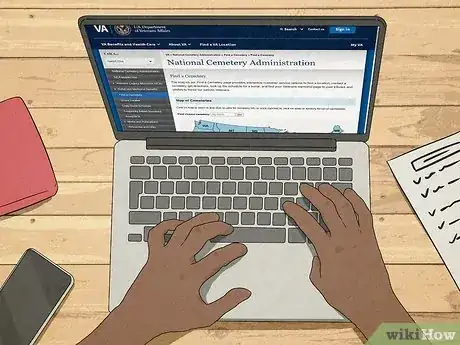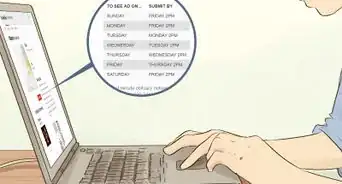This article was co-authored by wikiHow staff writer, Amy Bobinger. Amy Bobinger has been a writer and editor at wikiHow since 2017. She especially enjoys writing articles that help people overcome interpersonal hurdles but frequently covers a variety of subjects, including health and wellness, spirituality, gardening, and more. Amy graduated with a B.A. in English Lit from Mississippi College in 2011 and now lives in her hometown with her husband and two young sons.
There are 7 references cited in this article, which can be found at the bottom of the page.
This article has been viewed 323,694 times.
Learn more...
Visiting the grave of someone who's passed away can be a great way to pay your respects and get closure, or just to learn more about a historical figure. However, if you don't know exactly where the person was buried, it might seem hard to find the gravesite. Luckily, as long as you have just a little information about the person, there are a number of ways you can find out where someone is buried.
Steps
Searching Individual Headstones
-
1Visit the cemetery if you know where it is. If you know the cemetery where someone is buried but you're not sure exactly which plot is theirs, take a trip to the graveyard. Plan to go early in the day, in case it takes you a while to find the exact location.[1]
- Since you'll be walking around outside, bring along a bottle of water, and apply sunscreen before you leave the house. If you're going in the summertime, you'll need to reapply the sunscreen if you'll be outside for more than 2 hours.
- Depending on the time of year and where you're going, it may be a good idea to bring bug spray.
-
2Look online or at the visitor's center for a map. Some cemeteries have websites with a map of all of the graves on their grounds, while others will have maps available on site. If you can find a map, it could save you a lot of walking while you search for an individual grave.
- Some of these maps will list individual graves, while others might include only family plots. Some may even be just a basic grid outline of the cemetery, but even that can help you streamline your search.
Advertisement -
3Start at one side of the cemetery and make a pattern. If you don't know the general location of the grave, it's best to start in one corner of the cemetery and walk along the pathway from one end to the other. That way, you don't end up accidentally looking in the same areas you've already been.
- It may be helpful to bring a piece of paper and a pencil and draw a rough diagram of the cemetery to help you keep track of the plots you already looked at.
- If it's a very large cemetery, you may need to have someone else start at the other side or break your visit into multiple days.
-
4Reach out to the sexton of the cemetery if you still can't find the grave. The cemetery sexton is the person in charge of overseeing the grounds. In addition to performing general maintenance in the cemetery, the sexton also keeps records of all of the burials. They should be able to tell you the exact location of the gravesite.[2]
- You might also be able to speak to the clergy who oversaw the services. Even if they don't have a record, they may remember the general area in which the person is buried.
-
5Contact the funeral home for help if the cemetery is privately owned. Some cemeteries are owned by the funeral home itself. If that's the case, you can contact the director of the funeral home to find out the location of the grave.[3]
- Often in this situation, the funeral home will be located on the grounds of the cemetery.
-
6Look for a family plot with the person's last name. In a cemetery, you'll often see last names grouped together. If you see another grave with the same family name as the person you're looking for, you may be getting close.[4]
- This is because families often buy multiple graves at the same time so they can be laid to rest together. These groupings are called family plots.
-
7Compare the birth and death dates with the time the person lived. Just because you find a gravesite with the same name as the person you're looking for, it doesn't necessarily mean you've found them. Check the information on the headstone to see if the birth and death dates match up to verify it's the right grave.
- If you don't know the person's exact date of birth or when they died, at least try to estimate when they would have lived.
Checking Death Records
-
1Gather as much information about the person as you can. When you're searching records, you'll need to have the first, middle, and last name of the person, whenever possible. You're likely to have more luck if you also know their date of birth, when and where they died, and the names of their immediate family members.[5]
- Since some combinations of first and last names are more common, having the person's middle name will help narrow down your search significantly.
- If you're not sure of the person's full name, their date of birth, or when they died, try looking in family bibles, baptismal records, or obituaries.
- You may be able to find the person's death certificate by contacting their local county clerk's office. However, if the person died before the 1930s, they may not have a death certificate.
-
2Look up the person in genealogy databases. If you'd like to know the location of your ancestor's burial site but you don't know where to start looking, a genealogy database can help. Even if you can't find the exact location of their grave, you may be able to discover where the person lived and died, which can help you narrow down where they're probably buried.[6]
- Many of these sites require a fee to use all of their features, although you may be able to sign up for a free trial in some cases.
- Two of the most popular genealogy websites are https://www.ancestry.com/ and https://www.archives.com/.
-
3Visit virtual cemetery websites. Once you know the area where the person is buried, you may be able to find their grave online at a virtual cemetery website or headstone database. Even if the cemetery itself doesn't maintain an independent website, a database may include a photograph of their headstone and it's location in the cemetery.[7]
- In many cases, volunteers take photos of gravesites and upload them.
- One of the most popular cemetery databases is https://www.findagrave.com/. You could also check https://billiongraves.com/.
- There may also be databases which are specific to your region. For example, if you're Dutch, you could visit https://www.dutchgenealogy.nl/online-cemeteries/.
-
4Browse sites for veterans if the person was a service member. There are specific sites dedicated to preserving the locations of servicemen and women who have passed away, whether they died in the line of duty or after their service had ended. If the person you're searching for served in the military in some way, check these sites for more information.[8]
- Two sites that might be helpful include https://www.vets.gov/burials-and-memorials/find-a-cemetery/ and https://m.va.gov/gravelocator/.
- If you're looking for someone buried in a specific military cemetery, check to see if there's an independent website. For instance, you can find the location of a grave at Arlington National Cemetery by visiting https://www.arlingtoncemetery.mil/Explore/Find-a-Grave.
Community Q&A
-
QuestionMy uncle was given a pauper's funeral by Liverpool City Council in 1977. There is no name on the burial plot and I believe there is more than one person in the grave. How can I find the plot?
 Community AnswerYour uncle was buried with a metal number disc. Your City Council should have a record of the place, date, and time you uncle was interred.
Community AnswerYour uncle was buried with a metal number disc. Your City Council should have a record of the place, date, and time you uncle was interred. -
QuestionCan a cemetery charge a fee to tell you where a grave is?
 Community AnswerNo, they'll ask for when the person died and/or when they were buried. Sometimes they might ask your relation to the deceased.
Community AnswerNo, they'll ask for when the person died and/or when they were buried. Sometimes they might ask your relation to the deceased. -
QuestionI have the friend's name, where they lived, when and where they died, but no obituary to note interment. Is this enough?
 Community AnswerUnless the person is from a very big town and has an exceedingly common name, this should be sufficient. Many people never have obituaries written about them.
Community AnswerUnless the person is from a very big town and has an exceedingly common name, this should be sufficient. Many people never have obituaries written about them.
References
- ↑ https://familyhistorydaily.com/genealogy-help-and-how-to/planning-a-cemetery-visit-important-dos-and-donts-to-read-before-you-go/
- ↑ https://careertrend.com/info-8083938-duties-sexton.html
- ↑ http://www.nfda.org/news/statistics
- ↑ https://www.nytimes.com/2010/04/04/fashion/04genb.html
- ↑ https://familyhistorydaily.com/genealogy-help-and-how-to/find-a-gravesite/
- ↑ https://familyhistorydaily.com/genealogy-help-and-how-to/find-a-gravesite/
- ↑ https://www.familysearch.org/blog/en/tips-sleuthing-cemeteries-ancestors/
- ↑ https://www.arlingtoncemetery.mil/Explore/Find-a-Grave
About This Article
To find a person’s grave, check online or in the cemetery entrance for a map of the graves. Failing that, locate the sexton, who might be able to help you find the grave. If neither of those work, start in one corner and read the gravestones in a pattern to make the most of your time. To find the grave of an ancestor, try checking genealogy databases like Ancestry for the location of their grave. Even if their exact plot isn’t listed, you might find out where and when they died. For more tips, including how to find the graves of veterans, read on!
